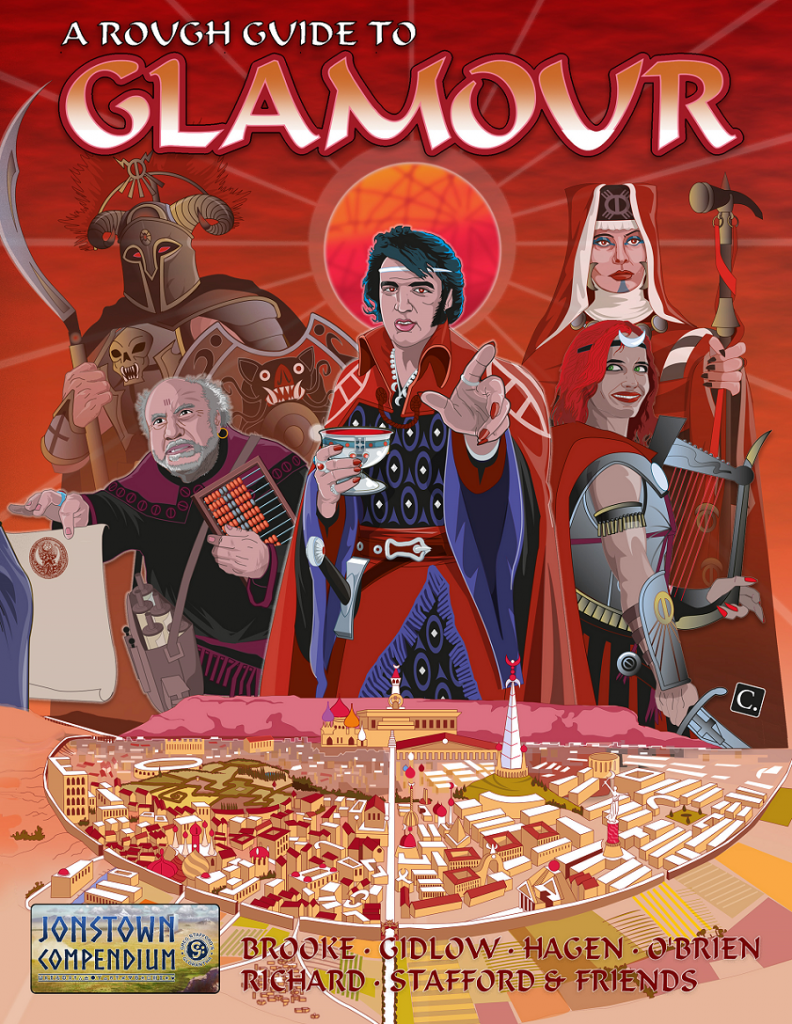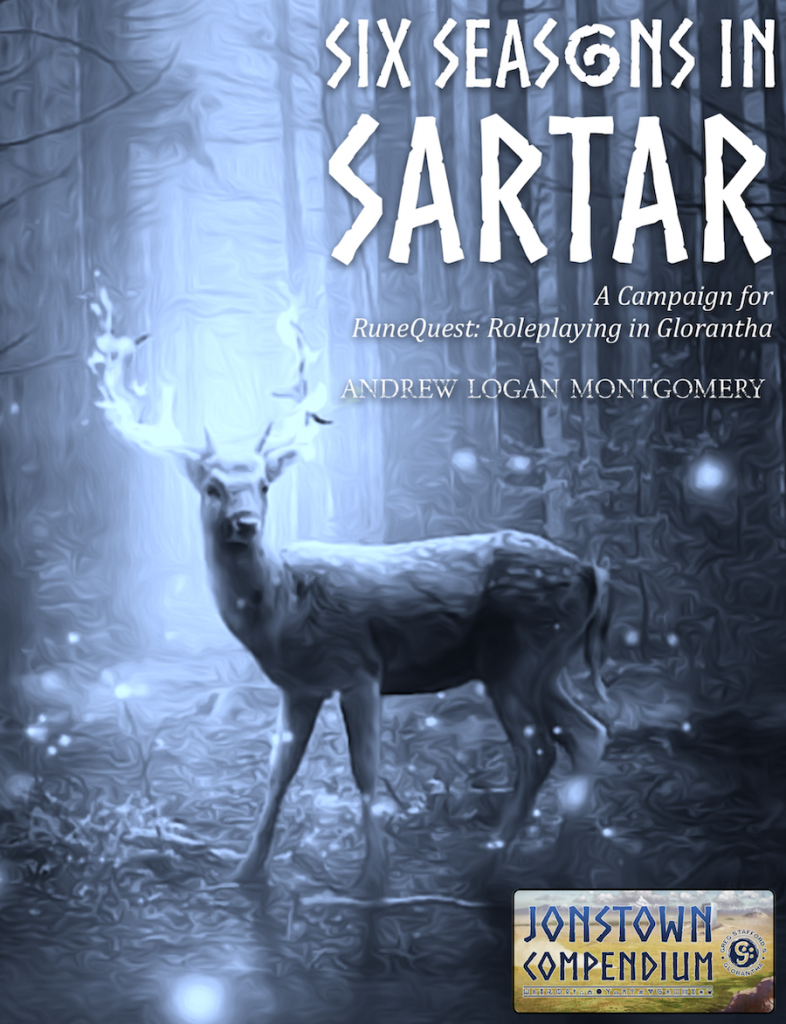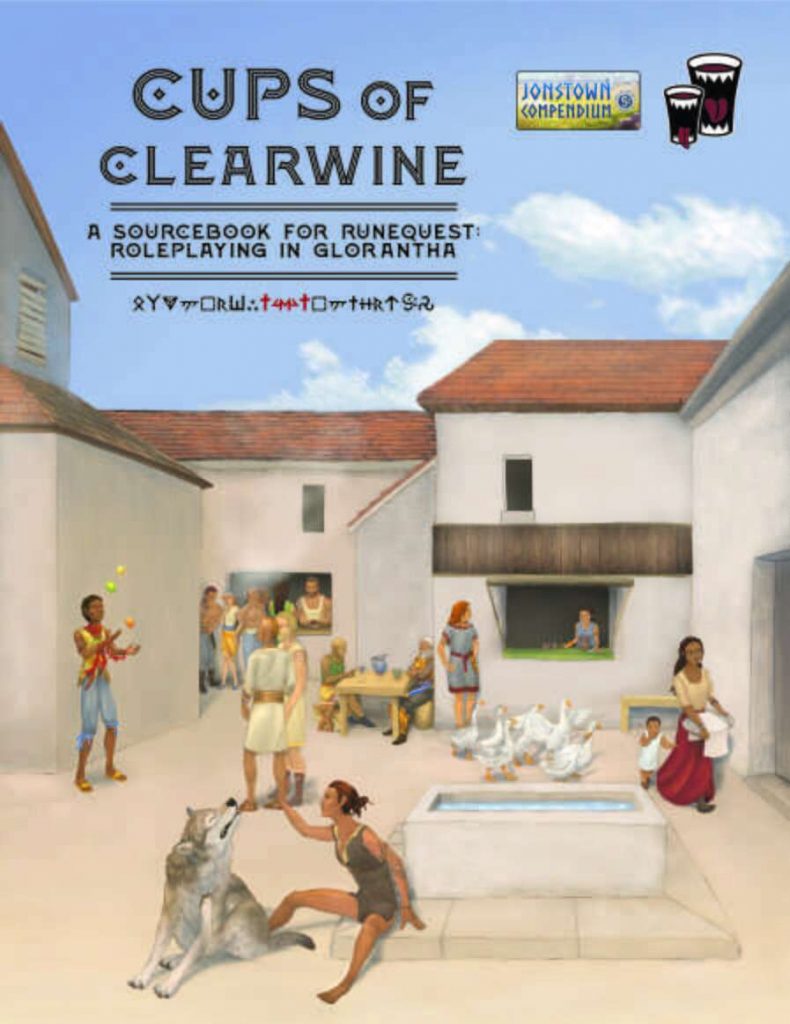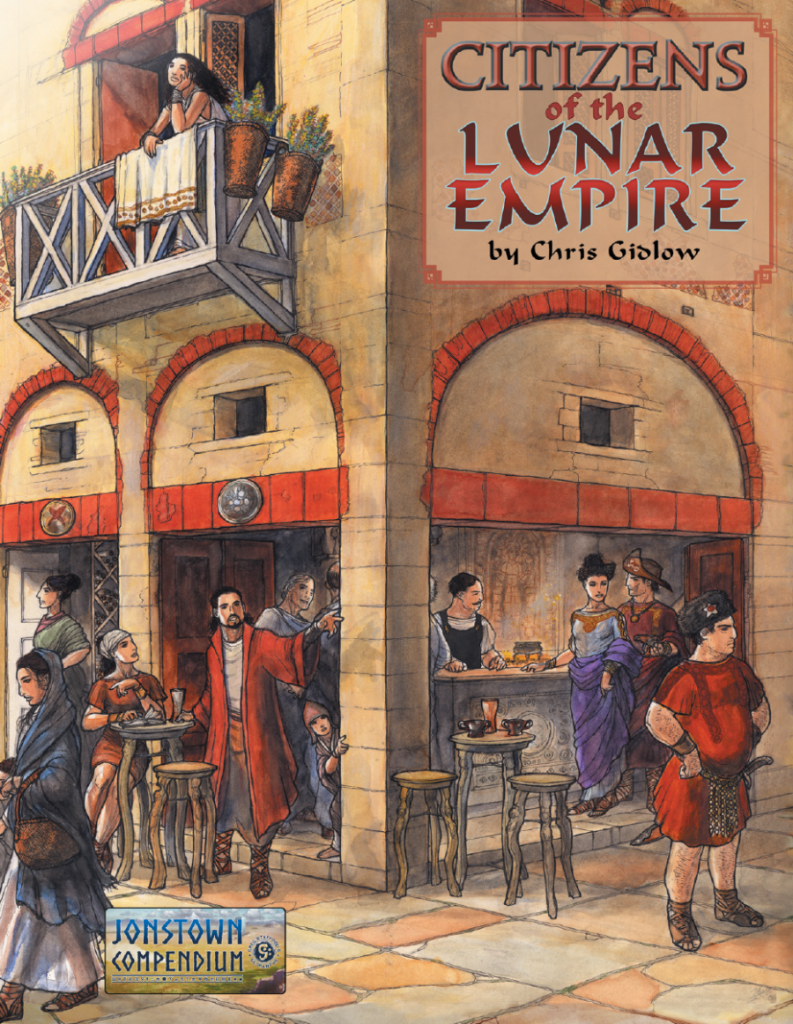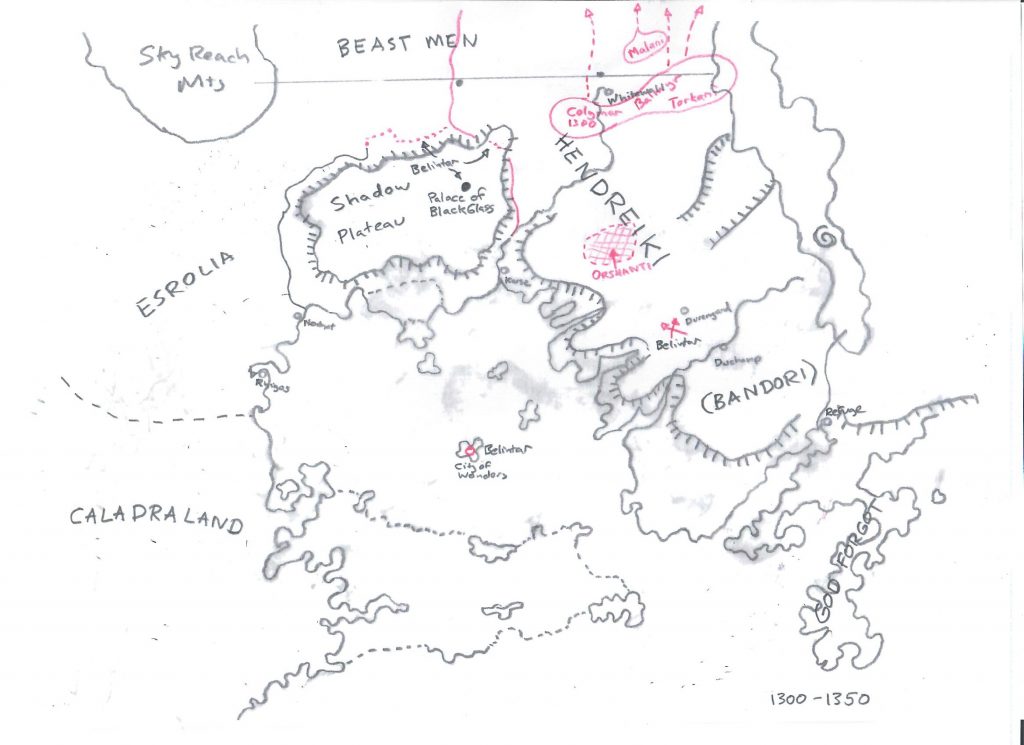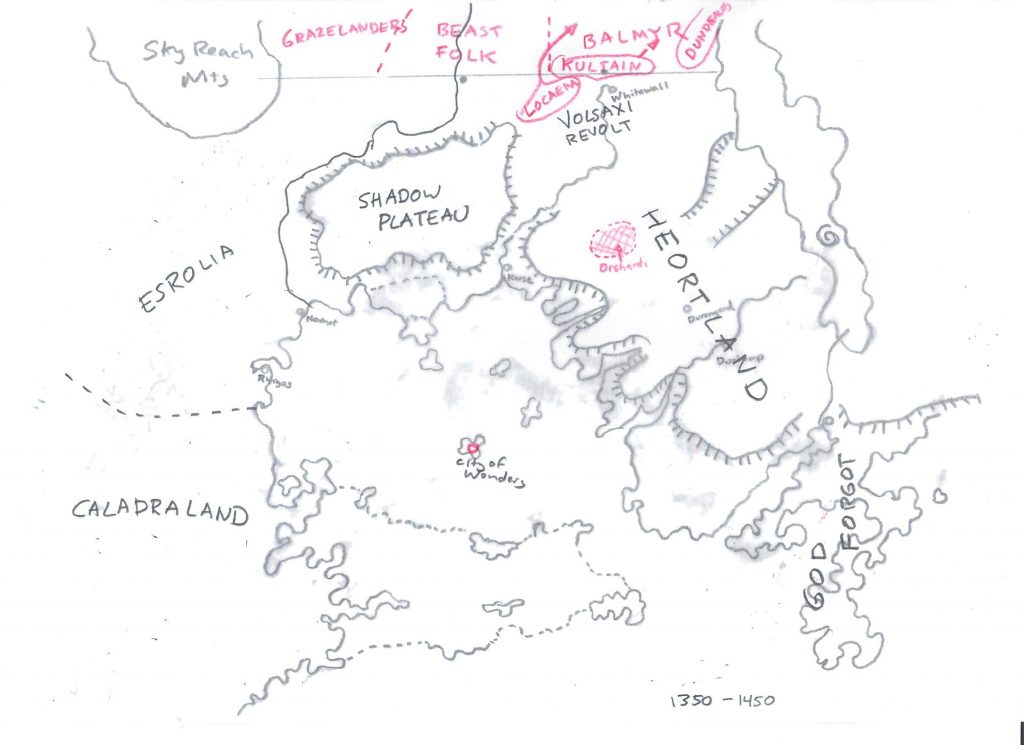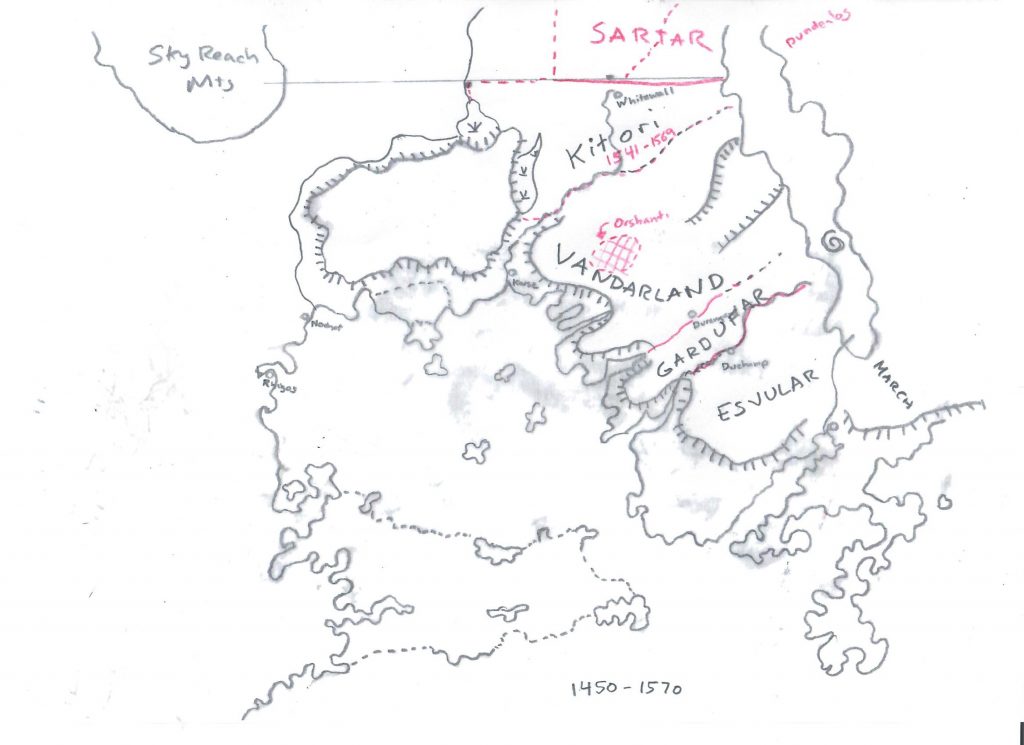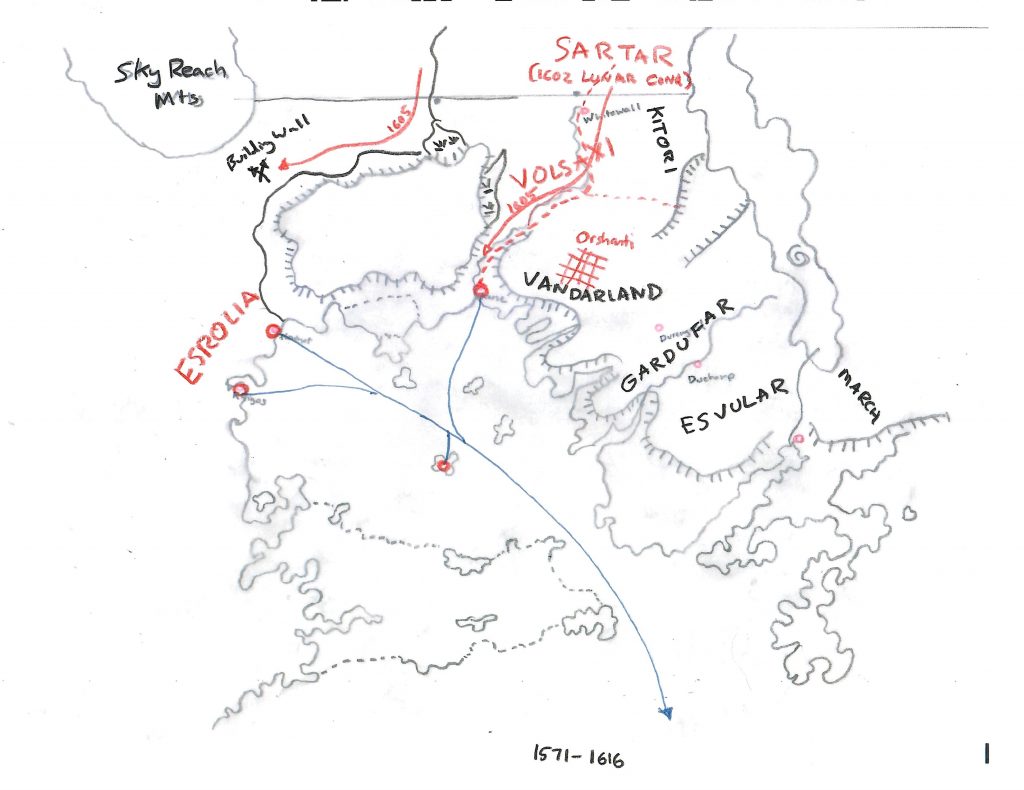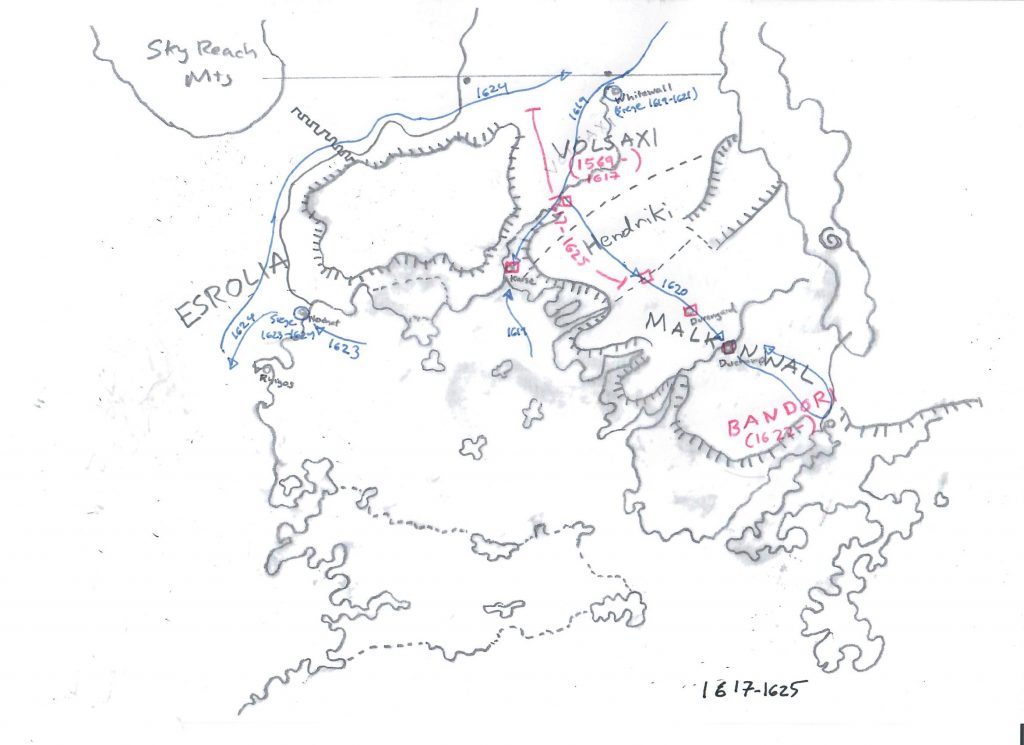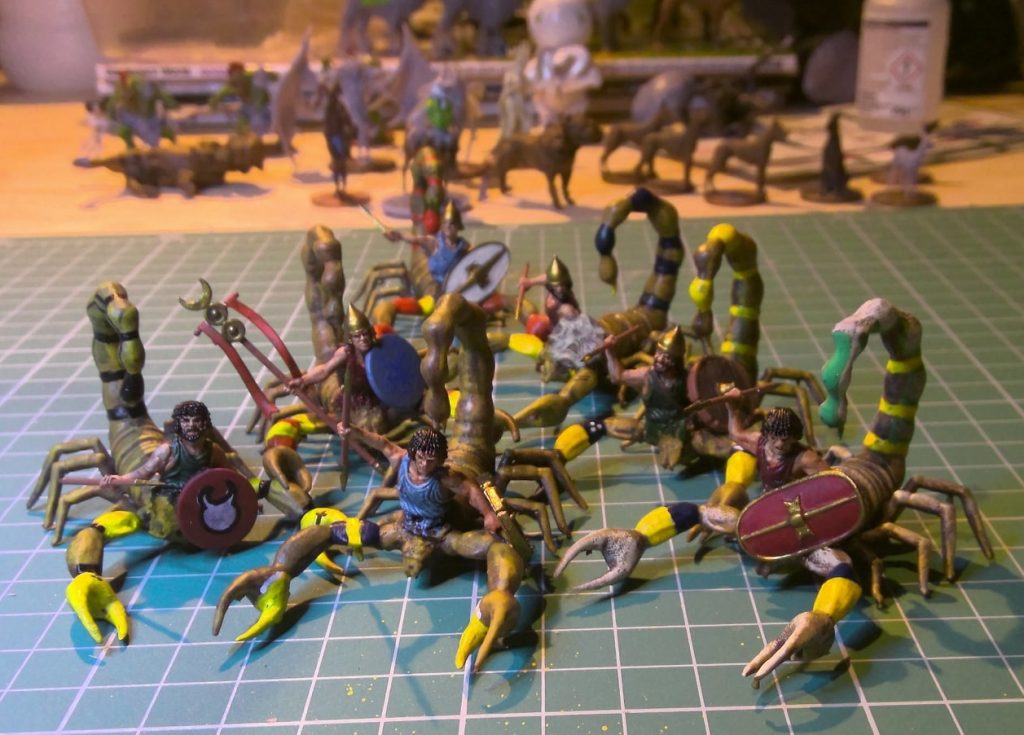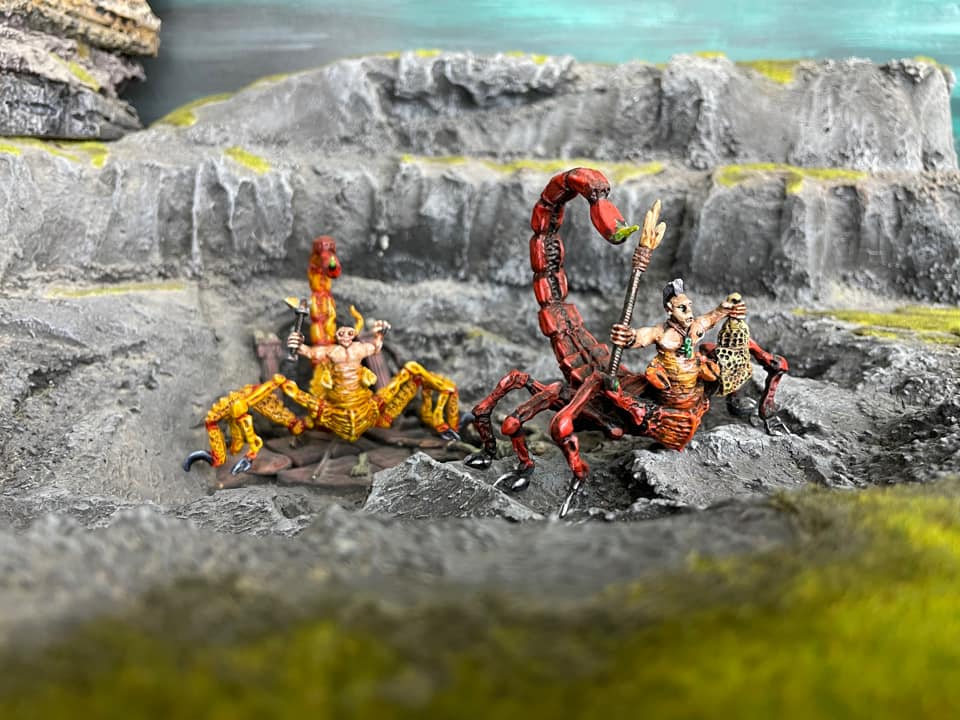Welcome to a new issue of the Journal of Runic Studies, the premier Malkioni publication for studies into the nature of Glorantha. If you haven’t subscribed yet, please consult with the spirit bound to the appropriate electronic page.
Chaosium News

Here are this week’s Chaosium news!
Ossi Hiekkala on the Weapons & Equipment Guide Cover
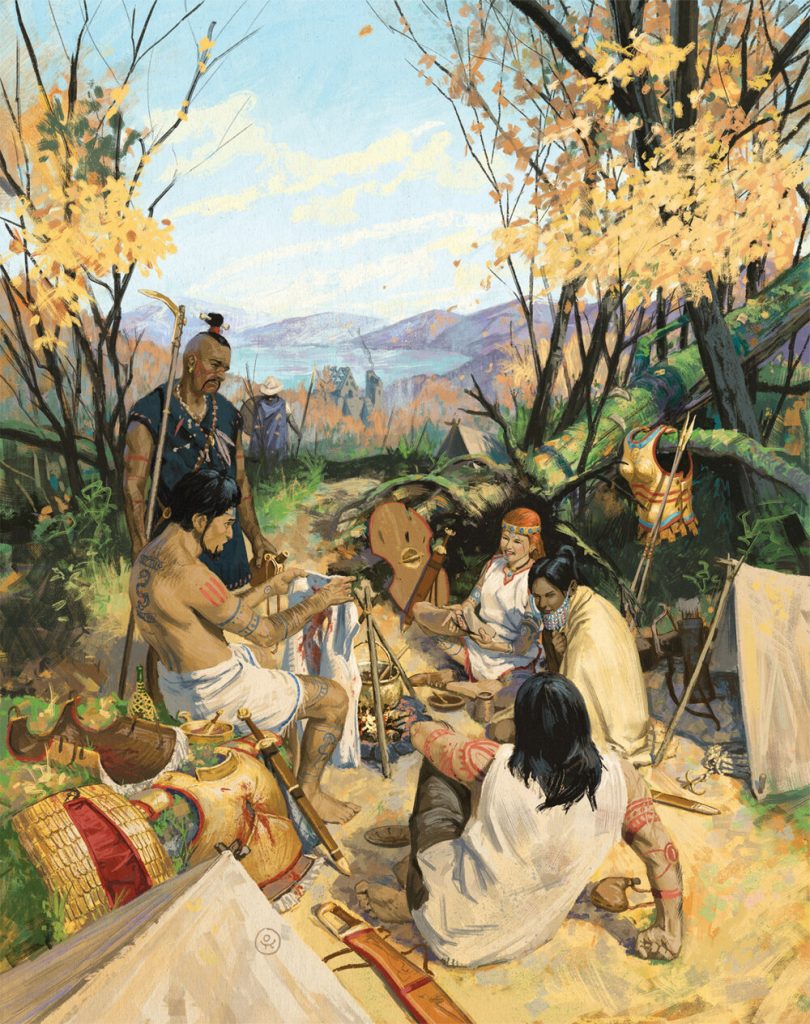
Cover artist Ossi Hiekkala blogged about his work on the upcoming Weapons & Equipment guide, which is absolutely wonderful.
Instead of the obvious choice of showing gear porn, I painted the group of pre-gen characters camping and enjoying each other’s company after their previous encounters and before the eventual hard adventuring the next day, a scene that must be very common for any RPG group, but not often portrayed in the cover art. I am delighted Chaosium was happy to go with this kind of unorthodox cover image.
Joerg was telling me recently that the German RuneQuest community was analyzing this cover and linking it to the action scene depicted on the cover of the Starter Set… for instance, is the damage on Harmast’s armor related to how his fight against the Krarshtkid went? The answer lies with Jason Durall!
The Starter Set is already out (although I’m still waiting for it to arrive…), and the Weapons & Equipment guide is coming out in PDF on December 10th.
Chaosium Hosting New RuneQuest Player Stream
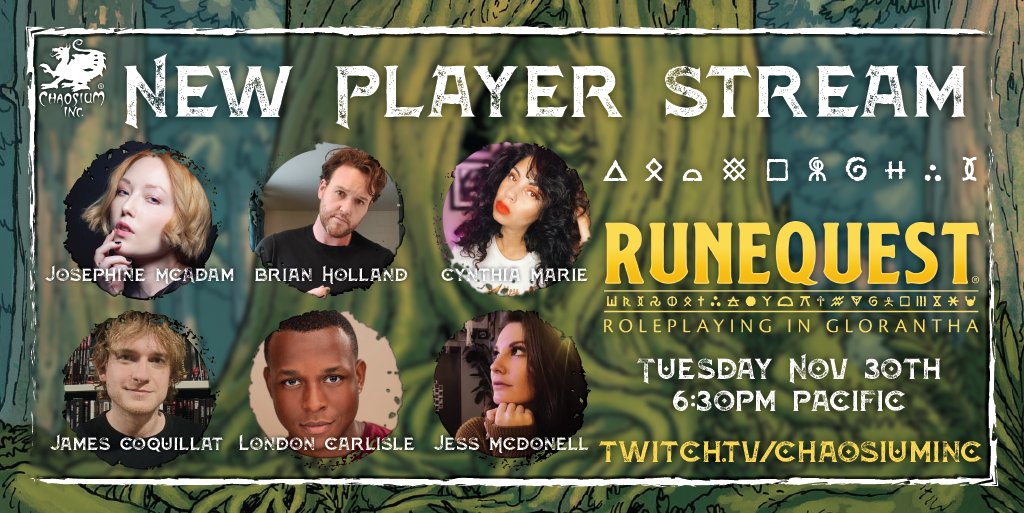
On November 30th, Chaosium’s Twitch channel will host a RuneQuest game with a diverse cast of new players. James Coquillat (of Chaosium’s YouTube channel fame) will play along, and Brian Holland (Chaosium’s Marketing Director) will act as Gamemaster.
I assume they will play one of the Starter Set adventures, but who knows? I’m pretty excited to watch this!
Jonstown Compendium

The Jonstown Compendium is Chaosium’s community content program for all Gloranthan games, hosted on DriveThruRPG. Disclaimer: all the relevant links are affiliate links that hopefully will let us cover some of the hosting and maintenance costs for the website and podcast! Thanks for using them!
Monster of the Month’s Burning Engines

It’s the end of the month so that means a new Monster of the Month! The penultimate one, actually, and it gives information about Burning Engines, some dwarven machines meant to protect their catacombs. As always, you get more than just a few monsters since this one includes adventure seeds and other cool stuff like sorcery spells to control one of those things! I’m pretty sure having a big robot as a pet would make you famous.
Armies and Enemies of Dragon Pass Now in Print-on-Demand

Martin Helsdon’s monster book has been made available in print thanks to the no-doubt herculean layout efforts of Nick Brooke. Martin received the Greg Stafford Memorial Award for Gloranthan Fandom in part for his work detailing all the warriors, soldiers, and mercenaries of Dragon Pass and its surroundings. If your players are getting involved in the Hero Wars, this is a must have source.
Note that the print version is in black & white. The PDF remains in colour, but I don’t think we’re missing much, since the colour parts were either illustrations taken from the Guide to Glorantha and other existing sources, or colored tables and text boxes. All of Martin’s core work, featuring illustrations of almost every possible fighter type, was always in black & white.
Sandheart Volume 4 Now in Print-on-Demand
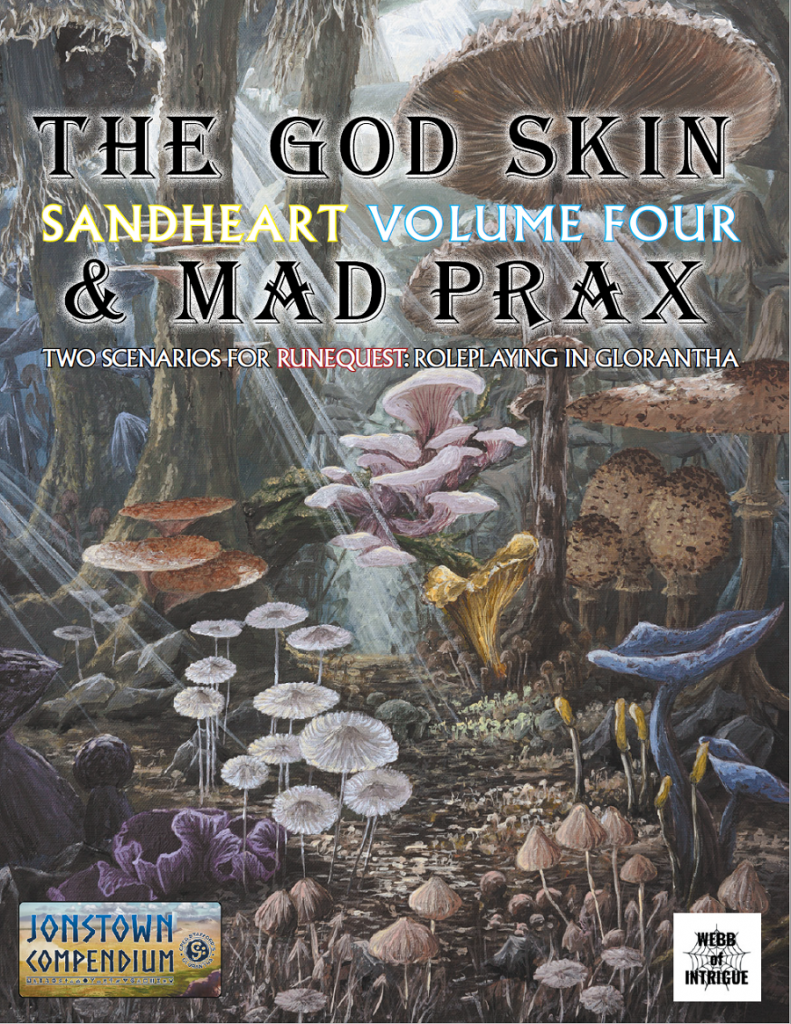
The fourth volume of the excellent Sandheart series is now also available in print-on-demand!
Thanksgiving Sales!
There are many Jonstown Compendium books on sale for the holidays! Including the books from the “Nick Brooke Cinematic Lunar Empire” (A Rough Guide to Glamour, Life of Monsoon Book 1 and Book 2, Citizens of the Lunar Empire), the Andrew Logan Montgomery campaigns (Six Seasons in Sartar and Company of the Dragon), the Sandheart books (Volume One is here but check out the other ones too!), the Beer With Teeth collection (such as the Dregs and Cups of Clearwine), Martin Helsdon’s aforementioned big-ass Armies and Enemies of Dragon Pass, and more!
Jeff’s Notes

Jeff Richard, the current mastermind on everything Gloranthan at Chaosium, is often posting notes and thoughts on the RuneQuest Facebook group. Here’s our curated list from the past week. A partial archive of these sources is compiled on the Well of Daliath.
About Aeolians
On BRP Central, Jeff shared a lot of information about the Aeolians. First, some background: Heortland is the area of the Holy Country that is South-East from Sartar, and from where (roughly) many of the Sartarite tribes originally came from (e.g. see the Colymar tribe’s history in the Gamemaster Screen Pack Adventures).
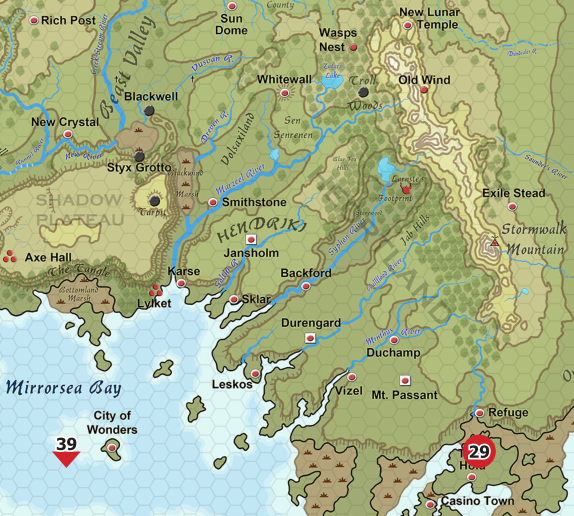
While most of Heortland is historically inhabited by Orlanthi people, the Southern part of the area is where the Esvularing people live, from Leskos to Mount Passant and all around the Bandori Valley where Refuge is located (see map above).
The Esvularing were atheists long ago (like the people from God Forgot, further South), but now they follow a henotheist variation of Malkionism which is called Aeolism. Basically, they worship the Invisible God as the Supreme Creator (like the Malkioni), but acknowledge the Orlanthi pantheon as “emanations” of this Supreme Creator. So they participate in Orlanthi rituals as well. When you’re not sure who’s correct, you might as well do both, right?
Jeff suggests looking at the Druze or Mandaeans as source of inspiration for Aeolians. From the very little I can tell about them, the Druze are monotheists who built their faith from a variety of other Abrahamic religions, and are mostly located in the Levant. The Mandaeans are originally from the Mesopotamian region but have now spread among several western countries. They feel closer to how I picture Invisible God-worshipping people in Glorantha: they are Gnostics who believe in a supreme formless “Entity”, along with various derived deities and spirits, all of which are part of cult secrets.
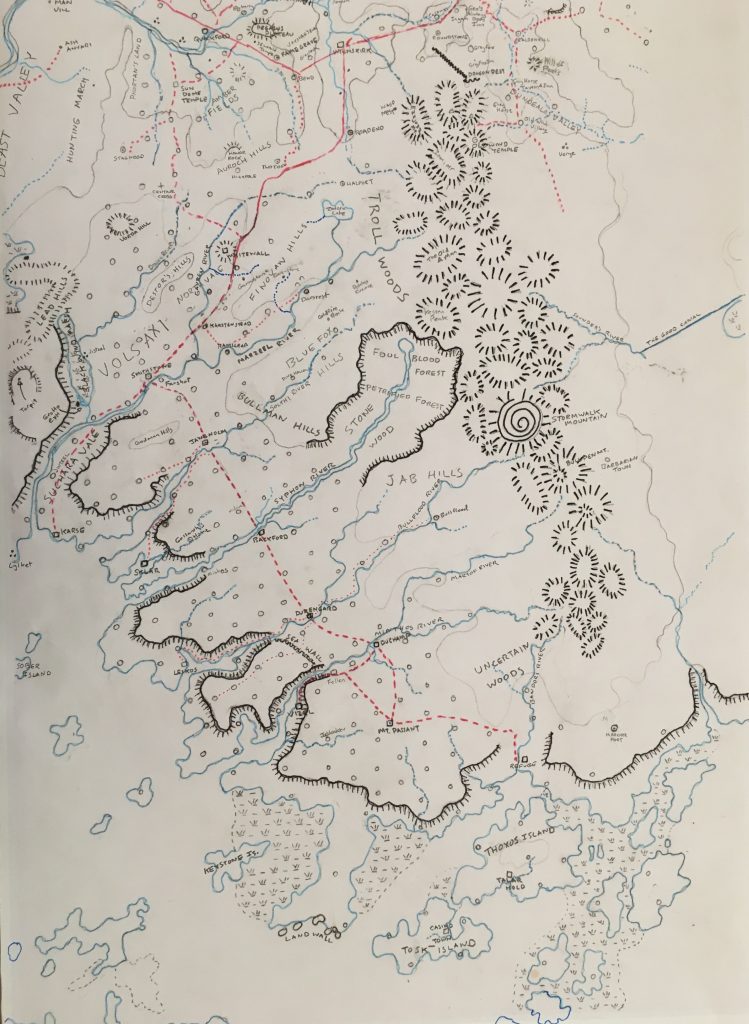
However, Jeff also warns to not “overplay the influence of the Aeolians”, especially since Heortland is quite big. The Orshanti might have a lot more importance, since this is where important figures like Sartar and Colymar hailed from originally:
Presumably the Orshanti remained an influential kinship group in Heortland, linked by blood, trade, and religion to the House of Sartar.
The geographical, cultural, and familial proximity can’t be understated:
[…] Volsaxar and Vandarland are going to have lots of ties and influences to Sartar. Marriages, shared cult, language, and culture, and trade are going to mean that the people of northern Heortland are virtually indistinguishable from Sartarites.
And yet, Belintar is the beloved God-King here because he brings the God Realm into proximity of the mundane world. Heortland is part of the Holy Country, while Sartar is carved out of the wilderness.
Meanwhile at the southern tip of Heortland, we have the Aeolians of Esvular, who are clearly influenced by both the Orlanthi and the Malkioni of God Forgot.
Awesomely enough, Jeff also shared some historical maps of the region to illustrate this point:
It shows the exodus of the original Sartarite tribes (Colymar, Balmyr, and so on) in the early 14th century, the rise of Belintar as God-King, the founding of the Royal House of Sartar, along with other population movements and important events. I believe that the last map shows the Lunar invasions and retreats around the Holy Country. Of note, and according to the Guide, the Bandori tribe was not put under Lunar occupation like the rest of Heortland. Instead, it sounds like they had a “tenuous independence from the Empire”, which I suppose was negotiated by the sorcerer rulers of Refuge.
Meanwhile in central Heortland many customs such as a mounted elite warriors that are selected from aristocratic families and their status approved in assemblies, are clearly influenced by the Malkioni, while at the same time the culture is very similarly to the Sartarites. These mounted elite warriors supported Rikard the Tiger-Hearted’s short lived kingdom (1618-1620) and now many serve as mercenaries.
As for picturing the cities of Heortland, and Mount Passant in particular, Jeff suggests looking at Pergamon and Priene (respectively by Anasynthesis and Rocío Espín Piñar):


Broos Are People Too
A thread on BRP Central asked whether Broos are considered people or not… You can bet that such a poorly phrased question immediately caught fire and devolved into the kind of nasty dispute better reserved for Thanksgiving family dinners, but hey, guess what? American Thanksgiving is today! (at the time of me writing this of course… oh and by the way, unsurprisingly enough, the thread was locked after several pages demonstrating the downsides of Gloranthan fandom)
Anyway, why do I bring this up? It’s because Jeff dropped by the thread in its early hours (yes, I was surprised about this too) to provide a few nuggets of wisdom. As always, any answer to any question depends on who you ask in Glorantha, and as always, the Lunars are the most open-minded:
“Personhood” is a complex philosophical question with all sorts of legal and political ramifications. The only group I can think of that might appreciate the question and its implications are the Lunars – for them, all self-aware beings are “persons” and are capable of embracing the Lunar Way. That includes broo, ogres, and even things like vampires or self-aware jolanti.
The Lunars have had some success with it:
Now some Illuminated Lunars believe that if broo are taken outside of their awful conditions and taught the Lunar Way (including self-discipline and social skills), they can be useful members of society. The Lunars have been able to constructively negotiate with Ralzakark, and are able to send caravans through Dorastor to Ralios without molestation. But even within the Lunar Empire, most people hate and fear broo, and things like the Seven Troubles from Dorastor are within living memory.
Dorastor is the Chaos-infested region located Southwest of the Lunar Empire. It was Nysalor’s Empire of Light a long time ago until Arkat “cleansed” it and it became a horror-filled nightmare. Yay, good job Arkat! Ralzakark is the Broo ruler of the region.
Jeff adds that other people, and other Elder Races, seem to treat Broos as dangerous monsters. Clever, yes, but monsters nonetheless. They must be killed or protected against or, at best, used as a weapon against enemies:
Most Gloranthans view broo as something like the Xenomorph from Alien – dangerously intelligent, but with no higher goals than self-propagation and infliction of pain on others. That is not actually true but it is true enough.
I figure that most Broos encountered as “roaming monsters” in a game are bound to be “feral Broos”, with not much more to them than a one big guy who tells them where to raid and kill. These would indeed be the “Xenomorph-types”, with their INT mostly allocated to predatory intelligence, and on the lower end of the curve.
Ecologically feral and wild broo are disasters. They impregnate as often as they can (think xenomorphs or parasitoid wasps) in order to propagate their species – domestic animals such as cattle or sheep are easiest, but humans or other beings also work. They have a hardy larval stage that matures rapidly, and few broo spend any resources socialising or educating the larvae (also it is rare for a broo to have any idea who its father is). Broo larvae are normally only permitted what they can take or steal. Surprisingly few die from this mistreatment but that is more due to their hardiness. The overwhelming majority of broo are unsocialised young adult males whose main goal is to survive and create a new generation of broo larvae. They are meat-eaters and are perfectly willing to eat their fellow broo. When there are too many broo in an area, they tend to kill and eat everything they can catch and need to move to a new region for food.
Another type would be “wild Broos”, which are nominally less savage than feral ones… but probably just enough to know how to say “I’ll kill your whole family” in Tradetalk, and have some Rune Magic from worship of Thed or Mallia.
Wild broo have cults and some social traditions (usually imposed by powerful and more long-lived broos), feral broo are little more than their life cycle.
But yet other Broos might be more “civilized”, such as those who are brought up as part of a complex society of Chaos worshippers, or those who form war bands employed by, say, the Lunar Empire. Sure, these Broos would still be nasty creatures who routinely commit atrocities that any Gloranthan society would punish with their worst sentence, but they have INT 2D6+6 and they can be reasoned with — the Lunar Empire and even some Praxian tribes did exactly that.
On a welcome practical gaming note, Jeff mentions that wild Broos would rarely ransom captives (or if they do, it’s a vicious trap!), but these “civilized” Broos are different:
Generally when honorable people fight broo they assume the rules of honourable combat don’t apply. That’s because most broo are feral or wild, and are treated like rabid animals. They give no quarter and ask for none. Nobody blinks an eye.
But sometimes the broo offer to parley. They sometimes offer ransom. They sometimes don’t molest their prisoners. Maybe that’s because they are civilised, or illuminated, or cleansed. Or maybe they are under orders from something they fear greatly. That’s when things get interesting, because the rules of honour require that they be followed. But at the same time, they are broos, and many cults treat them as Enemies.
And then there are the outliers, such as the “cleansed” Broo of the Zola Fel, who was freed from his Chaotic taint by the water god, or the allegedly Illuminated Wild Healer of the Rockwood Mountains, a Broo initiate of Chalana Arroy who has saved many lives, but is often mistaken for a feral Broo and hunted on sight.
Ultimately, it’s up to each gaming group to find what Broos are good for in their stories. Feral Broos are great for an hour or two of fun monster bashing every now and then, while more civilized Broos can add nuance and internal conflict to heroes whose convictions and world-views are tested against a bigger picture. As Jeff said: “that’s when things get interesting“. And I hope your games are indeed interesting!
Honour and Combat
As part of the aforementioned BRP thread on Broos, Jeff shared an excerpt from the upcoming Cults of Glorantha book on the topic of honour and combat:
Humakt demands that Death be wielded with honor and his cult upholds the code of honor in combat and war. This code is strictly adhered to by Humakti, but also generally followed by other honorable war gods such as Orlanth, Polaris, Yanafal Tarnils, Yelm, Yelmalio, and Yelorna.
Note how the Humakti follow this code “strictly” while the other cults only follow it “generally”. We know that several members of these other war-cults have committed war crimes, such as Harvar Ironfist, a Yelmalion Rune Lord, who killed and pillaged many lands during his bloody coup in 1611 in the Far Point. Arguably he was “helped” by Gagarthi warbands who have no honour, so maybe he blamed most of it on them… but I doubt it. Harvar is a piece of shit.
Honorable combat is not fought for gain or selfish reasons. Although Humakti often serve as mercenaries for pay, that payment is not supposed to be dependent on the outcome of the battle.
I’m pretty sure combat is almost always for gain or selfish reasons (vengeance, getting more land, getting the throne, etc), but I’m also pretty sure these people think it’s all honourable in their heads!
The buildup and formation of battle lines is done with the full knowledge of the other side and no surprise attacks are made.
This line got quite a lot of discussion over on the Chaosium Discord, where people took this a bit too literally, going as far as “sharing the composition of military units and attack plans with your enemy is madness! You can’t even flank them?“
I think the text here is just talking about the dishonorable aspect of launching a surprise attack on a nation, Pearl Harbor style. In this case, the “buildup and formation of battle lines” refers to the build up to a battle that can last anywhere from a few hours to several days. In the buildup to the Battle of Dangerford, for instance, both the Lunar and Sartarite armies camped on either side of the Creek, in view of each other, with the rebels ready for the Lunar phalanx’s attack. However, within that battle, each army of course adopted classic military tactics such as flanking, surprise cavalry reserves, and so on.
As for other types of surprise attacks, e.g. at the skirmish level, I would say that depends. The “never ambush anybody” geas is a common one with the Humakti, so if you don’t have it, you’re probably OK with it. Maybe don’t raise that Honor Passion too high, eh?
In battle, two warriors may duel or engage in prolonged personal combat. Both combatants must be armed and may use Rune or spirit magic, allied and other spirits, elementals, etc. Groups of warriors may fight approximately equal numbers of foes. However, multiple warriors or magicians must not gang up on a single warrior.
A warrior who surrenders becomes a prisoner of his capture and is under their protection. At the same time, a surrendered warrior must not flee his captor until ransomed or released.
This is all in line with what we see in epics, movies, and even the Starter Set SoloQuest, where protagonists fight a notable enemy while all the unnamed soldiers leave them alone, fighting their own smaller duels in the background.
Honor also dictates how warriors were to deal with noncombatants. No one should attack an enemy who has temporarily lost or dropped their weapon. The lives of noncombatants, prisoners of war, and farmers are also sacred. Pillaging the land is forbidden.
This last sentence also got debated a lot in the Chaosium Discord. My own interpretation is that there’s a fine line between pillaging recently conquered lands, and negotiation supply logistics and agreements with recently conquered populations. Alexander’s military successes were often thanks to his ability to do the latter. It doesn’t matter if he was entering these negotiations with a clear position of force and intimidation: at the end of the day, you either burn down people’s farms or you don’t. Also, like I said already, maybe don’t raise that Honor Passion too high?
Failure to follow the rules of honor can trigger a test of a combatant’s Honor Passion or even result in immediate reduction to that Passion (as per RuneQuest, page 234). Failure to act honorably may also result in a visit from the Spirit of Retribution of the offender’s cult.
Despite all of the above, Glorantha songs and stories are filled with examples of where a hero chose to act less than honorably where some other Passion (Loyalty, Love, Hate, etc.) dictates behavior instead of honor. Such conflicts are at the root of many a tragic hero.
Of note, players and gamemasters can also choose to just go with the dishonourable act without rolling anything, because they want the story to explore the adventurers coming to terms with the consequences… sometimes, the narration trumps the rules.
The rules of honor do not apply to animals, monsters, undead things unless they are capable of communicating or otherwise demonstrating that they do follow the rules of honor.
The Spread of the Lightbringers Religion
Jeff tells us about the early years of the Lightbringers Religion:
In the First Age, the Lightbringers Religion spread from its homeland in Dragon Pass across much of Genertela. These areas are where the Seven Lightbringers and their associates (Ernalda, Storm Bull, Mastakos, etc.) and friends (Humakt) are best known and recognized.
In Prax, the Lightbringers entered in the first century of the First Age. In the later Second Age, many Praxians fled to the Wastes where Waha, Eiritha, and Storm Bull proved most useful. In most of these areas the Lightbringer deities have more or less the same names, although they often have local titles and variants. Nonetheless, an Orlanth worshiper from Sartar will be able recognize and participate in worship in Ralios or Fronela. Indeed, some of the most important historical developments of these cults occurred outside of the core homeland and were only later embraced in Dragon Pass (e.g. Orlanth Rex).
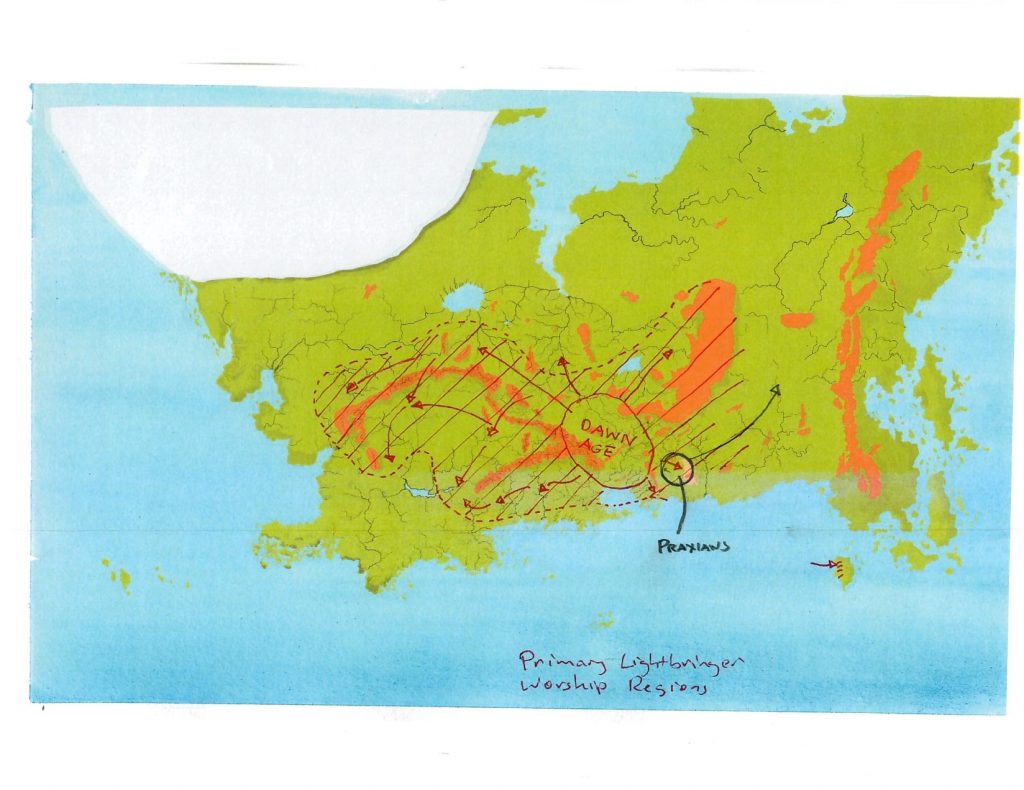
As far as I can tell, a lot of the HeroWars material, and many hard-core Gloranthaphiles, will use these “local titles and variants” freely, which can easily confuse newcomers and, well, myself. But I like the idea of occasionally using these variants (most probably by making my own because I probably can’t be bothered to remember the “official” ones) if and when my game ends up far from its homebase of Sartar. It might add a touch of “strangers in a strange land” which might lead to some fun roleplaying.
Anyway, if you wonder what kind of worship these Lightbringers displaced in the Dawn Age, it’s “whatever got the handful of survivors through the Great Darkness“.
Few of those spirits or minor gods provided much that was useful with the Dawn. The Theyalans brought social organisation, communication with outsiders, written records, agriculture and pastoralism, healing, and more. It is no wonder that the religion spread quickly across the Dawn Age landscape.
The Theyalans were nonetheless very good at proselytizing:
The Dawn Lightbringers had people who […] had great experience in recognising shared symbols and communicating that with [the locals]. The Theyalan Missionaries were probably the most skilled and successful missionaries in Gloranthan history (more than even the God Learners or the Lunars).
So when the Theyalans went out, they were looking for common points. Snippets of magical songs, secrets of life and death, magical languages, shared wisdom from the gods, that sort of thing. They’d find the commonalities and help build a shared understanding of the Dawn. Things and ideas fell into place and people embraced the Lightbringers, their associates, and friends – and the Theyalans learned from the experience.
It was thus a shock when the Theyalan missionaries into lowland Peloria were killed by horse riding barbarians who worshiped the Son of the Sun.
And now the most important bits in my opinion:
The Theyalan missionaries are why sixteen centuries after the Dawn, you can call on “Orlanth” by more or less the same name from Junora to the Elder Wilds.
You can imagine how important Issaries was in all of this. And of course Issaries continued his speaking and trade missions across the world with the Middle Sea Empire.
Community Roundup
The community roundup is our highlight of interesting things being mentioned in the Glorantha-related Facebook groups, sub-Reddits, and other similar online places.
Unboxing the Starter Set in the Nook
Pookie gets some help from a (shadow?) cat and a duck to unbox the Starter Set!
Exploring Glorantha Episode 12
JM and Evan come back to their long-running “Exploring Glorantha” series to offer a walk through the scenarios and campaigns currently available for gaming in Glorantha. They take a look at both official Chaosium material and the best fan-made books on the Jonstown Compendium.
Let’s Look at Some Miniatures
Duff Paint suggests that these minis from Hasslefree Minis could be used as Maran Gor temple eunuchs:
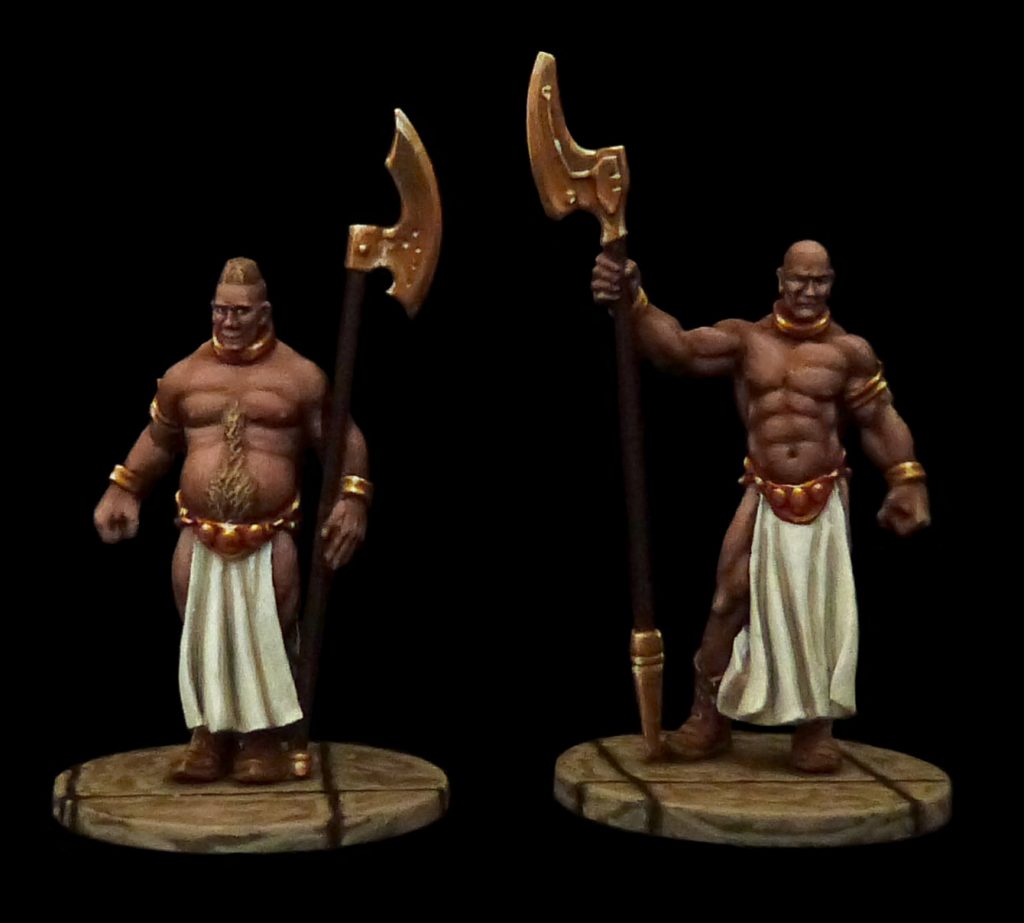
Here are some scorpionmen from Pete Rowans and Richard Helliwell respectively. Pete’s models are 3D-printed.
And last but not least, a Krarshtkid from Paul Baker!
Thank you for reading
That’s it for this week! Please contact us with any feedback, question, or news item we’ve missed!



